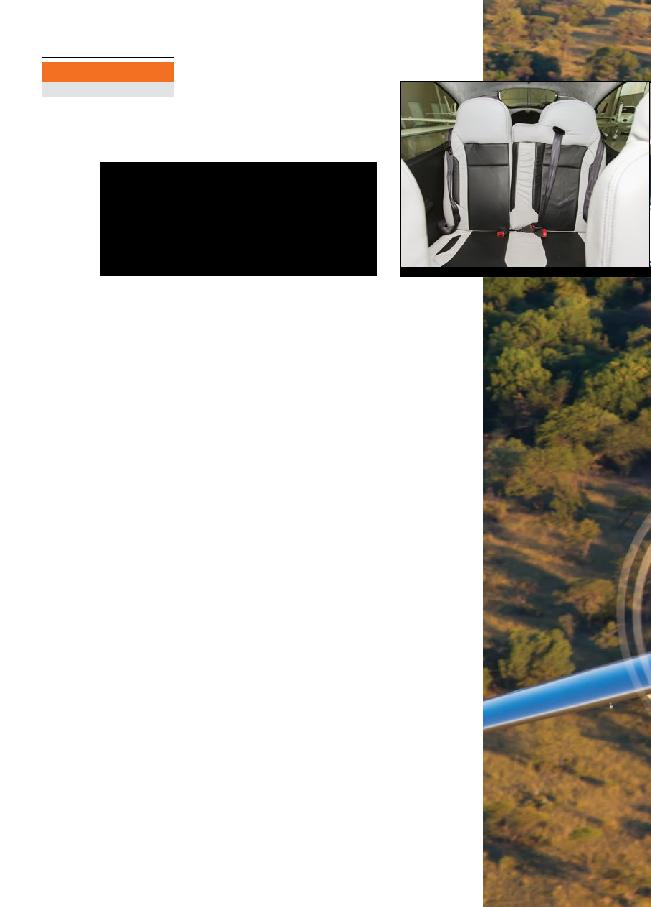
40
GA
/ Vol. 5 / No.9 / SEPTEMBER 2013
T
he newest addition to the
Cirrus family has just land-
ed and I was privileged to
take a close-up look at this
latest offering. The SR22 GTS title
comes with the added label of `G5'
denoting that this aircraft is the fifth
generation in the SR22's lineage. To-
day we are flying the turbo-charged
model of the G5.
Looks can deceive
The dawn of the new age is definitely
upon us. Ever-increasing numbers
of new composite aircraft types with
advanced avionics are appearing,
exerting more and more pressure
upon the ageing fleets of analogue-
equipped metal airframes. Whichever
side of the fence you may choose
to sit, this evolution is inevitable
and evident everywhere you look.
A high number of these new types
employ the efficient, lightweight
form of high-aspect ratio wings
and narrow aft fuselage sections
reminiscent of glider design. It is a
winning formula in many instances
and yet when first confronted by
a Cirrus it appears that a different
design philosophy has been adopted.
But looks can be deceiving.
The first impression of an SR22
is one of substance. It sits taller
than many of its contemporaries
and its aft fuselage doesn't taper
down to the same degree as other
designs. It still boasts very sporty
lines, but its overall presence is more
in keeping with the balance of a
`traditional' looking touring aircraft.
However, when the numbers are
examined more closely, its design
is most definitely of the new age.
Its 38-foot wingspan is on
par with comparable types and
its wing area of 145 square feet
is almost identical. Similarly, its
aspect ratio is in the same ball park.
The SR22's wing is an equally
efficient high-aspect ratio wing, but
it is masked to a high degree by the
shape and height of the fuselage.
With a MTOW of 1633kg it is
a heavier airframe than others in
the marketplace and this obviously
equates to a higher wing loading.
However, the SR22T GTS G5
(T for Turbo) has a Continental
TS10-550-K turbo-charged,
fuel injected 6-cylinder engine
under the cowling generating 315
brake-horsepower at 2,500rpm.
That equates to a power-loading
of around 11lb per horsepower.
This aircraft packs a punch.
For all of the numbers, this Cirrus
`Generation 5' is fundamentally a
powerful touring aircraft capable
of flight in the flight levels at over
200 knots. At 75% power, it burns
around 16 USG (60 litres) per hour.
It boasts a very generous, efficient
wing form; it just conceals it through
a very balanced overall appearance.
However, this first impression only
scratches the surface and its beauty
is truly more than skin deep.
An impressive blood-line
Cirrus proudly states that the SR22
has been "the world's best-selling
piston single for over 10 years'.
From its base-model that was first
certified in the year 2000, the type
has evolved through turbo-charged
variants to the latest G5 which was
released this year. Over this time
Cirrus has continued to prompt
excited conversations through its
ever-present `wow factor' of sporty
performance and the latest in interior
comfort and avionics suites.
Additionally, Cirrus has always
attracted attention through its
standard equipage of the Cirrus
Airframe Parachute System (CAPS).
Mounted aft of the cabin on the upper
fuselage, the CAPS is deployed
by a rocket pulling the parachute
clear of the aircraft before fully
opening the canopy and allowing
the airframe to descend at a safe rate
back to earth. It can be deployed
as low as 600 feet and up to 140
knots, although there is a recorded
successful deployment at 187 knots.
As the SR22 design has
progressed, it has always maintained
a relatively consistent profile that
automatically identifies the aircraft
as a Cirrus. In fact, parked beside
an earlier generation model, the
G5 is difficult to discern from its
forebear. However, the G5 is a
very different aircraft in some very
simple, yet significant ways.
Firstly, the MTOW of the
aircraft has increased by 90kg over
the earlier SR22s to 1633kg. That
simple figure equates to an additional
passenger or extra baggage that
can be uplifted. Coincidentally, the
rear seat now has the capability to
seat three people, although they
would most likely be children.
In terms of performance, the
turbo-charged G5 has a maximum
true-airspeed of 214 knots and a
maximum altitude of 25,000 feet.
With a maximum fuel capacity of 350
litres the aircraft has a range of over
800nm. Now let's tie these numbers
together into a real life scenario.
The fixed-gear turbo-charged G5
can lift four standard adults, fly at
a true airspeed of 210 knots in the
flight levels and still have a range of
900nm or over 1,000nm for a slight
reduction in airspeed. Impressive!
The increase in MTOW meant
that the wing-spar needed to be
strengthened and that increase in
weight was offset by sacrifices
elsewhere in the standard give-and-
take of aircraft design. However,
a tremendous by-product of the
development of the G5's wing
was a strengthening of the flaps
allowing deployment of the first
stage of flap (50%) up to 150
knots; an increase from 119 knots
of its predecessor. For a high
performance aeroplane, this is a
tremendous asset in slowing down
as the traffic pattern looms ahead.
The G5 also possesses the
approval to fly into known icing
conditions. Tell-tale strips on the
Flight Test
By Owen Zupp - Pics: Mark Mansfield
Style
and
Substance
Cirrus
SR22 GTS G5

